Hurricanes
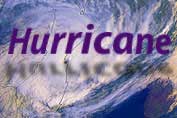
What's a hurricane?
A hurricane
is a type of tropical cyclone, which is a generic term for a low pressure
system that generally forms in the tropics. The cyclone is accompanied by
thunderstorms and, in the Northern Hemisphere, a counter clockwise
circulation of winds near the earth's surface.
Tropical cyclones with maximum sustained surface winds of less than 39 mph
are called "tropical depressions".
Once the tropical cyclone reaches winds of at least 39 mph they are
typically called a "tropical storm" and assigned a name.
If winds reach 74 mph, then they are called: a "hurricane" in the North
Atlantic Ocean, the Northeast Pacific Ocean east of the dateline, or the
South Pacific Ocean east of 160E. In the Northwest Pacific Ocean west of
the dateline the cyclone is called "typhoon".
How and where do these monsters develop?
A tropical cyclone
needs several ingredients and conditions to develop.
-
Warm ocean waters (of at least 80°F) throughout a sufficient depth
(unknown how deep, but at least on the order of 150 ft). Warm waters are
necessary to fuel the heat engine of the tropical cyclone.
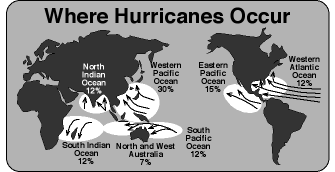
-
An unsettled atmosphere which cools fast enough with height. In such an
atmosphere thunderstorm easily develop and it's the thunderstorm
activity which allows the heat stored in the ocean waters to be
liberated for the tropical cyclone development.
-
A minimum distance of at least 500 km [300 mi] from the equator. This
has to do with the pressure the turning earth brings to bear upon the
atmosphere. For the birth of a tropical cyclone, there is a requirement
for certain amounts of this pressure.
-
Tropical cyclones cannot be generated spontaneously. To develop, they
require a weakly organized system with sizable spin and low level
inflow.
-
Low values (less than about 23 mph) of vertical wind shear between the
surface and the higher altitudes of the atmosphere. Vertical wind shear
is the magnitude of wind change with height. Large values of vertical
wind shear disrupt the incipient tropical cyclone and can prevent
genesis, or, if a tropical cyclone has already formed, large vertical
shear can weaken or destroy the tropical cyclone by interfering with the
organization of deep convection around the cyclone centre.
To be short the ingredients for a hurricane
include a pre-existing weather disturbance, warm tropical oceans,
moisture, and relatively light winds aloft. If the right conditions
persist long enough, they can combine to produce the violent winds,
incredible waves, torrential rains, and floods we associate with this
devastating monster from nature; that threatens many lives over and over
again.
The Azores
high
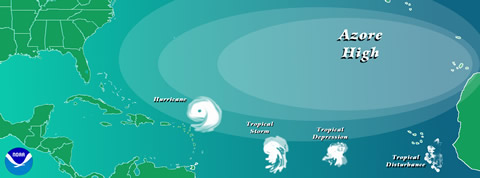
It has been
recognized since at least the 1930s that lower part of the
atmosphere (from the ocean surface to about 3 miles) westward travelling
disturbances often serve as the "seedling" circulations for a large
proportion of tropical cyclones over the North Atlantic Ocean. These
disturbances, now known as African easterly waves, had their origins over
the North African coast.
A very important ingredient is the co-called African easterly jet. This
jet arises as the result of temperature difference between the extremely
warmth over the Saharan Desert and the substantially lower temperatures
along the Gulf of Guinea coast.
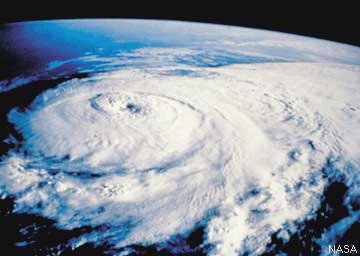 When
these two air masses meet, the atmosphere will become very unstable and
(very heavy) thunderstorms, with areas of low pressure, develop. These
storms and lows travel west with the trade wind flow across the Atlantic
Ocean. They are first seen usually in April or May and continue until
October or November. When the conditions, as described above, are there; a
hurricane is born. But, thankfully, most of these thunderstorms will die
out and never reach the hurricane-stage. On average, about 60 storms and
lows are generated over North Africa each year, but it appears that the
number that is formed has no relationship to how much tropical cyclone
activity there is over the Atlantic each year. When
these two air masses meet, the atmosphere will become very unstable and
(very heavy) thunderstorms, with areas of low pressure, develop. These
storms and lows travel west with the trade wind flow across the Atlantic
Ocean. They are first seen usually in April or May and continue until
October or November. When the conditions, as described above, are there; a
hurricane is born. But, thankfully, most of these thunderstorms will die
out and never reach the hurricane-stage. On average, about 60 storms and
lows are generated over North Africa each year, but it appears that the
number that is formed has no relationship to how much tropical cyclone
activity there is over the Atlantic each year.
While only about 60%
of the Atlantic tropical storms and minor hurricanes originate from these
African thunderstorms and lows, nearly 85% of the intense (or major)
hurricanes have their origins as a severe thunderstorm. It is even
suggested, though, that nearly all of the tropical cyclones that occur in
the Eastern Pacific Ocean can also be traced back to Africa.
It is currently
completely unknown how those easterly thunderstorms change from year to
year in both intensity and location and how these might relate to the
activity in the Atlantic (and East Pacific).
El Niņo and
Hurricanes
Does El Niņo (a
sudden rise of seawater temperature in the east-Pacific, before the
Peruvian coast) affect hurricanes?
Its likely that the answer is "yes". Of course one autumn will bring more
and more severe hurricanes than another autumn. For example in 1997 the
Caribbean got seven tropical storms but only three grew out to hurricanes.
This small amount of hurricanes was certainly due to a very strong
El Niņo during that year.
El Niņo changes the
jet streams, a strong westerly at about 30.000 feet. During a strong El
Niņo the jet stream grows stronger and moves somewhat southwards to
the Caribbean. So at higher altitudes the winds become stronger than
normal, and the huge towering complexes of clouds, which normally
accompanies and reinforces a hurricane are blown to pieces; with the
result that the storm dies out.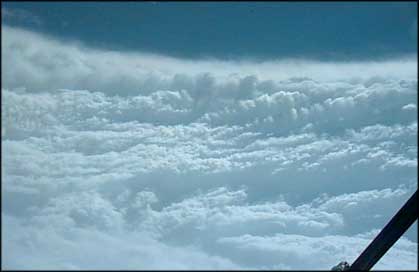
The year 1997 was a
strong El Niņo-year, followed by two La Niņa-years (1998 en 1999). During
a La Niņa the Peruvian Seawater is colder than normal. This had a
immediate impact on hurricane activity; eight visited the Caribbean and
the American south-east coast; whereby Mitch, end of October 1998,
was the strongest and most devastating hurricane ever; reaching class 5.
The El Niņo effects at the American West coast is reverse. During an El
Niņo year the coast will be visited by more hurricanes.
But not only El Niņo influences the amount of hurricanes in the Caribbean.
There is also a connection with the weather in Western Africa, the Sahel.
The rain- and thunderstorms in that area are a source for lows. These lows
can produce tropical storms and eventual hurricanes, as explained above.
Hurricane names
The WMO (World Meteorological Organization) has redacted a list of
names that will be used for coming hurricanes. In the past it was already
usual to name a hurricane after the saint of the day at which the
storm brought destruction and terror to a country. Like in 1825 on the
26th of July Puerto Rico was visited by Santa Ana. During the 20th century
hurricanes were named after the latitude and longitude, but that appeared
to be very confusing.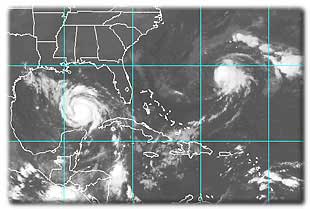
During the WO II meteorologists started with names in alphabetical order,
the first storm of the season started with an "A", the second a "B',
etc.
Eventually in 1970 the American Hurricane Centre came with a list of
names, that were repeated every 10 years. The Director choose the names of
the women in his family.
This leaded to protests from feministic organizations and in 1979 the
names were altered male and female.
At the moment the WMO has a list of names for tropical depressions,
when the wind reaches force 8 Beaufort, for the coming six years. These
names will be repeated, except for the names which eventually where
devastating. These names won't be used anymore.
Warnings
Meteorologists can rather accurately calculate the track a hurricane will
follow.
The threatened population of an area can be warned and evacuated in time.
Especially the Hurricane Centres in the United States are very specialized
in this part of meteorology. And due to them, the number of victims is
strongly reduced during the last decennia.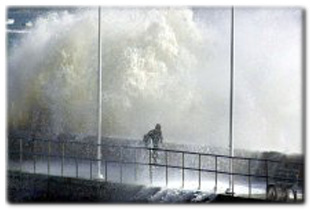
The hurricane-prone area is intensively scanned with scouting planes; but
also buoys at sea, or data from satellites and radar are available for
calculations.
Only area's with very bad communication and living-conditions, like
Central America and Bangladesh, for example, can severely suffer under
tropical cyclones.
And many lives are lost again and again.
Why don't we try to destroy tropical cyclones?
By using silver iodide:
Actually for a couple decades NOAA and its predecessor tried to weaken
hurricanes by dropping silver iodide - a
substance that serves as a effective ice nuclei - into the rain bands of
the storms. The idea was that the silver iodide would enhance the
thunderstorms of the rain band by causing the super cooled water to
freeze, thus liberating the latent heat of fusion and helping the rain
band to grow at the expense of the eye wall. With a weakened convergence
to the eye wall, the strong inner core winds would also weaken quite a
bit. Neat idea, but it, in the end, had a fatal flaw: there just isn't
much super cooled water available in hurricane convection - the buoyancy
is fairly small and the updrafts correspondingly small compared to the
type one would observe in mid-latitude continental super or multi-cells.
The few times that they did seed and saw a reduction in intensity was
undoubtedly due to what is now called "concentric eyewall cycles".
A substance on the ocean surface: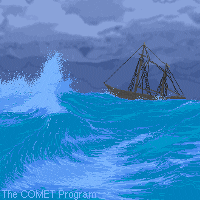
As for the other ideas, there has been some experimental work in trying to
develop a liquid that when placed over the ocean surface would prevent
evaporation from occurring. If this worked in the tropical cyclone
environment, it would probably have a detrimental effect on the intensity
of the storm as it needs huge amounts of oceanic evaporation to continue
to maintain its intensity However, finding a substance that would be
able to stay together in the rough seas of a tropical cyclone proved to be
the downfall of this idea.
Nuking them:
Lastly, there always appears ideas during the hurricane season that one
should simply use nuclear weapons to try and destroy the storms. Apart
from the concern that this might not even alter the storm, this approach
neglects the problem that the released radioactive fallout would fairly
quickly move with the trade winds over land. Needless to say, this
is not a good idea.
By
etc:
Perhaps the best solution is not to try to alter or destroy the tropical
cyclones, but just learn to co-exist better with them. Since we know that
coastal regions are vulnerable to the storms, enforce building codes that
can have houses stand up to the force of the tropical cyclones. Also the
people that choose to live in these locations should willing to shoulder a
fair portion of the costs in terms of property insurance - not exorbitant
rates, but ones which truly reflect the risk of living in a vulnerable
region.
Last but not least the SCALE
Hurricanes can be classified. The scale that is often used is
from Saffir-Simpson, as given below. To give an indication: the most
devastating hurricane, Mitch, October 1998, was a class 5 hurricane.
|
SAFFIR-SIMPSON SCALE
|
|
Scale
NR
|
Central
Pressure
|
Winds
MPH
|
Surge
FT
|
Damage
|
|
1
|
>28.94" (>980mb)
|
74-95
|
4-5
|
Minimal
|
|
2
|
28.91-28.50" (979-965mb)
|
96-110
|
6-8
|
Moderate
|
|
3
|
28.47-27.91" (964-945mb)
|
111-130
|
9-12
|
Extensive
|
|
4
|
27.88-27.17" (944-920mb)
|
131-155
|
13-18
|
Extreme
|
|
5
|
<27.17" (<920mb)
|
>155
|
>18
|
Catastrophic
|
Photo's from NOAA; National Hurricane Centre
With thanks to: www.NOAA.com
Mail to:
wijke@scribeweekly.com
Archive
of Scribeweekly Weather Specials
|



 When
these two air masses meet, the atmosphere will become very unstable and
(very heavy) thunderstorms, with areas of low pressure, develop. These
storms and lows travel west with the trade wind flow across the Atlantic
Ocean. They are first seen usually in April or May and continue until
October or November. When the conditions, as described above, are there; a
hurricane is born. But, thankfully, most of these thunderstorms will die
out and never reach the hurricane-stage. On average, about 60 storms and
lows are generated over North Africa each year, but it appears that the
number that is formed has no relationship to how much tropical cyclone
activity there is over the Atlantic each year.
When
these two air masses meet, the atmosphere will become very unstable and
(very heavy) thunderstorms, with areas of low pressure, develop. These
storms and lows travel west with the trade wind flow across the Atlantic
Ocean. They are first seen usually in April or May and continue until
October or November. When the conditions, as described above, are there; a
hurricane is born. But, thankfully, most of these thunderstorms will die
out and never reach the hurricane-stage. On average, about 60 storms and
lows are generated over North Africa each year, but it appears that the
number that is formed has no relationship to how much tropical cyclone
activity there is over the Atlantic each year.


